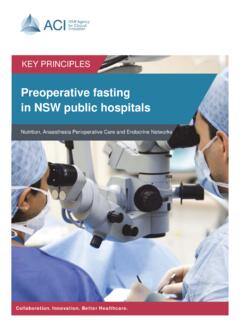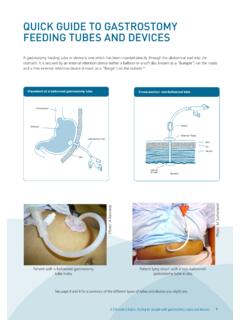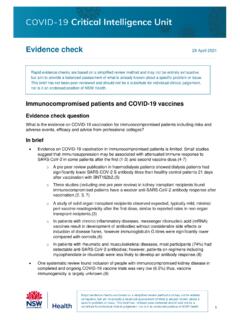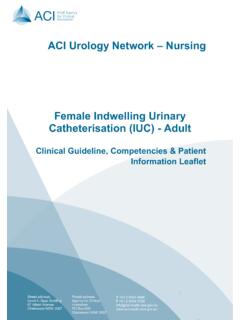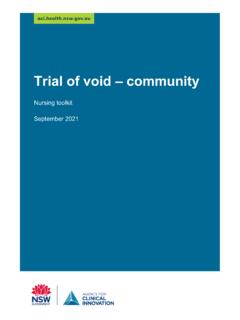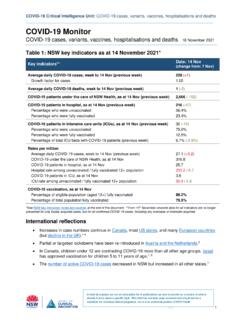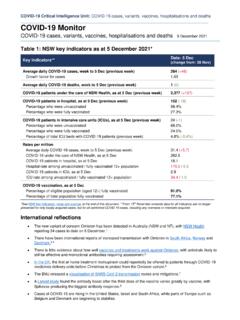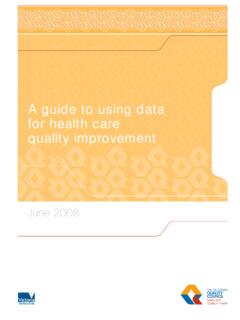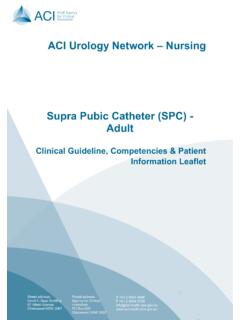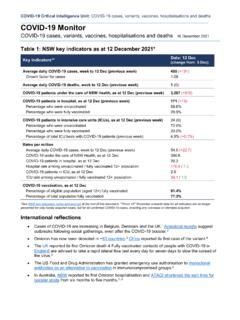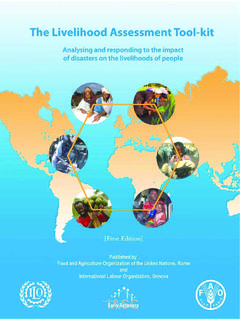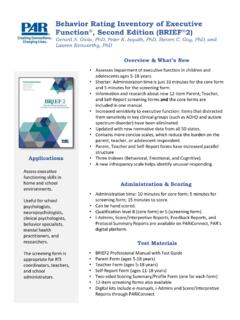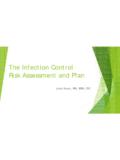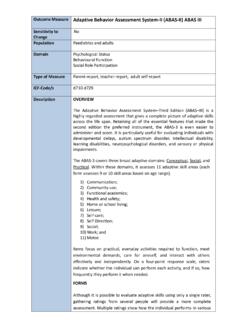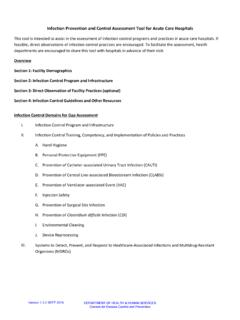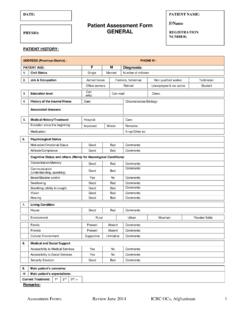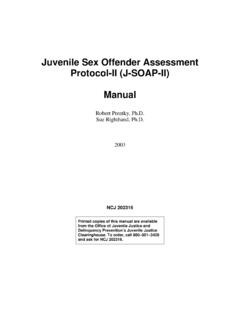Transcription of Neurovascular Assessment
1 Neurovascular AssessmentGUIDEACI Musculoskeletal NetworkACI Musculoskeletal Network Neurovascular Assessment GuidePage 2 The Agency for Clinical Innovation (ACI) works with clinicians, consumers and managers to design and promote better healthcare for NSW. It does this by: service redesign and evaluation applying redesign methodology to assist healthcare providers and consumers to review and improve the quality, effectiveness and efficiency of services specialist advice on healthcare innovation advising on the development, evaluation and adoption of healthcare innovations from optimal use through to disinvestment initiatives including guidelines and models of care developing a range of evidence-based healthcare improvement initiatives to benefit the NSW health system implementation support working with ACI Networks, consumers and healthcare providers to assist delivery of healthcare innovations into practice across metropolitan and rural NSW knowledge sharing partnering with healthcare providers to support collaboration, learning capability and knowledge sharing on healthcare innovation and improvement continuous capability building working with healthcare providers to build capability in redesign.
2 Project management and change management through the Centre for Healthcare Clinical Networks, Taskforces and Institutes provide a unique forum for people to collaborate across clinical specialties and regional and service boundaries to develop successful healthcare innovations. A priority for the ACI is identifying unwarranted variation in clinical practice and working in partnership with healthcare providers to develop mechanisms to improve clinical practice and patient care. Agency for Clinical Innovation67 Albert Avenue Chatswood NSW 2067PO Box 699 Chatswood NSW 2057 T +61 2 9464 4666 | F +61 2 9464 4728 E | (ACI) 180821; ISBN 978-1-76081-037-5 Produced by: Musculoskeletal NetworkFurther copies of this publication can be obtained from the Agency for Clinical Innovation website at : Content within this publication was accurate at the time of publication. This work is copyright. It may be reproduced in whole or part for study or training purposes subject to the inclusion of an acknowledgment of the source.
3 It may not be reproduced for commercial usage or sale. Reproduction for purposes other than those indicated above, requires written permission from the Agency for Clinical Innovation. Version: V2; ACI _ 0147 [10/18]Date amended: November 2018 Trim: ACI/D18/4938 Cover Image: Shutterstock 312219719 Agency for Clinical Innovation 2018 AcknowledgementsThe ACI thanks the following Working Group members for their contribution to the development of this guide and supporting resources, including the McEvoyWorking Group Lead, Clinical Nurse Consultant Orthopaedics, Liverpool Hospital, South West Sydney LHDC heryl BaldwinClinical Nurse Consultant Orthogeriatrics, Gosford Hospital, Central Coast LHDIan StarkeyHead of Department Physiotherapy, Blacktown Mount Druitt Hospital, Western Sydney LHDJane O'BrienClinical Nurse Specialist Orthopaedics, Lismore Base Hospital, Northern NSW LHD Linda RossClinical Nurse Consultant Orthopaedics, John Hunter Hospital, Hunter New England LHDB elinda MitchellClinical Nurse Consultant Orthopaedics, Westmead Hospital, Western Sydney LHDM egan WhiteClinical Nurse Consultant Musculoskeletal, Concord Repatriation General Hospital, Sydney LHD Melissa DavisClinical Nurse Educator, Royal North Shore Hospital.
4 Northern Sydney LHDP enny AndersonClinical Nurse Educator General Surgery, Lismore Base Hospital, Northern NSW LHDR obyn Speerin Manager, Musculoskeletal Network, Agency for Clinical InnovationACI Musculoskeletal Network Neurovascular AssessmentPage 3 GlossaryAcute limb ischaemiaA sudden decrease in limb perfusion that threatens the viability of the limb. AbductionMovement of the limb away from the midline of the body. AdductionMovement of the limb towards the midline of the body. AnticoagulantsA substance or drug that reduces the tendency of blood to coagulate, thereby reducing the risk of thrombosis. BlanchingA test of blood circulation in the fingers and toes. Pressure is applied to a fingernail or toenail until normal colour is lost, the pressure is then removed and circulation colour is allowed to return. Compartment syndrome A condition resulting from increased pressure in a muscle compartment. This compromises the blood flow and/or nerve supply to the muscle compartment leading to impaired circulation, tissue perfusion and motor function.
5 DorsiflexionUpward flexion of the part of the body, as the hand, foot or toes are pushed towards the body. Dorsalis pedis The pulse of the dorsalis pedis artery which is palpable between the first and second metatarsal bones on the top of the foot. DorsumThe posterior or upper surface of a body part. ExtensionAn increase in the angle between the bones of a limb at the joint. For example, extension of the leg increases the angle between the femur and the limb (arm or leg). FlexionA decrease in the angle between the bones of the limb at a joint. For example, bending the elbow decrease the angle between the humerus and the excess of blood in part of the body caused by an increased blood flow, such as the inflammatory response, local relaxation of arterioles, or obstruction of the outflow of blood from an oedemaA condition in which there is an abnormally large volume of fluid in the tissues between the body s cells (interstitial spaces). Medial malleolusBony prominence on the medial (inner) side of the assessmentThe sensory and motor function evaluation of the neurological and vascular integrity of a subjective sensation, experienced as numbness, tingling, or a pins and needles feeling.
6 Paralysis The loss of muscle function, loss of sensation, or both, causing powerless limb movement/immobility. Passive movementThe movement of parts the body by an outside force without voluntary action or resistance by the flexionWhen the toes are pushed down away from the tibialisThe pulse of the posterior tibial artery which is palpable behind the medial mallelous of the oppositionBringing the the thumb across (opposing) the hand to the fifth Musculoskeletal Network Neurovascular AssessmentPage 4 ContentsNeurovascular compromise or compartment syndrome 6 Purpose of this guide 6 Patients at risk of Neurovascular compromise or compartment syndrome 6 Frequency of assessments 7 Pain 8 Neurovasular Assessment procedures 8 Skin colour 9 Skin temperature (warmth) 9 Capillary refill 10 Pulses 10 Sensation 11 Movement 12 Swelling 13 Blood loss/ooze 13 Additional information 13 Compartment syndrome 14 Signs and symptoms 14 Nursing management 14 Documentation 15
7 References 15 ACI Musculoskeletal Network Neurovascular Assessment GuidePage 5 Purpose of this guideSurgical procedures, investigations or trauma can affect a person s circulation and nerve function to extremities. Neurovascular Assessment is performed to detect early signs and symptoms of acute ischaemia or compartment syndrome and support appropriate clinical purpose of this document is to provide guidance to clinical staff on: who is at risk of Neurovascular compromise or compartment syndrome accurate Neurovascular status Assessment requirements when to initiate prompt critical review and intervention for Neurovascular compromise when to escalate subtle changes to a patient s Neurovascular status documentation of Neurovascular team members should perform Neurovascular Assessment in accordance with the following at risk of Neurovascular compromise or compartment syndromeThe following injuries and/or procedures indicate that a patient is considered to be at risk of Neurovascular compromise or compartment syndrome, and therefore a Neurovascular Assessment must be performed.
8 Limb fractures vascular injuries and procedures trauma/surgery to limbs/joints external fixators casts, splints and constrictive dressings to limbs traction burns crush injury gunshot injury procedures that may cause limb thrombosis or emboli, cardiac catheterization interstitial oedema of limbs/massive intravenous fluid infusion prolonged immobility caused by drugs or alcohol induced coma snake envenomation anticoagulation therapy, compromise or compartment syndromePlease also refer the following documents: Neurovascular Assessment Form Upper Limb (Left and Right) Neurovascular Assessment Form Lower Limb (Left and Right) Acute Compartment Syndrome consumer informationACI Musculoskeletal Network Neurovascular Assessment GuidePage 6 Frequency of assessmentsThe frequency of assessments at a minimum should be: Documented medical ordersOR Hourly for 8 hours then Second hourly for 24 hours then Fourth hourly up to 60 hours (therefore from 24 hours to 60 hours) Increased frequency to half hourly if deficit identified OR Determined by condition of the patient at any given time and/or related procedural protocolsSome patients are not admitted for the duration of the recommended frequency of Assessment (for example, due to attendance to plaster clinics, day only procedures, emergency department visits).
9 They are exempt from the frequency outlined above. However, these patients must be provided written information/instructions about Neurovascular compromise prior to discharge. This should include information about the signs and symptoms of acute compartment who are dischargedACI Musculoskeletal Network Neurovascular Assessment GuidePage 7 Neurovascular Assessment should be conducted and recorded within the electronic medical record (eMR) as defined by all sections of the Neurovascular Observation Form and as outlined below. See Assessment is comparative. The unaffected limb should be evaluated to establish a baseline, prior to assessing the affected ,2,3 Prior to assessing the patient s Neurovascular status, ensure that: nail polish, dirt, blood or any stained skin preparation is removed from the distal extremities2 any jewellery is removed from the injured/affected limb, as it may cause constriction due to expected swelling there is full light (necessary to perform Neurovascular Assessment ).
10 1,2 The medical officer should be notified immediately of any deterioration or deviation in Neurovascular status. Deterioration or deviation in Neurovascular statusPainAny compromise to a patient s Neurovascular status will result in pain due to sensory nerve damage and diminished blood Neurovascular compromise may be indicated by: pain disproportionate to the injury deep, localised extreme pain unrelieved by analgesia increased pain upon passive stretch of the involved related form for this guideline has used the reference of the Numerical Rating Scale (NRS).4 Assess a patient s level of pain by asking the patient to rate the pain on a scale from 0 (no pain) to 10 (the worst pain imaginable).4 Consider the PAINAD (Pain Assessment in Advanced Dementia) tool for patients with cognitive Record whether there is any pain at rest (pain score). Record whether there is any pain at rest and on passive movement of the extremity (passive stretch), particularly for the affected muscle group.
